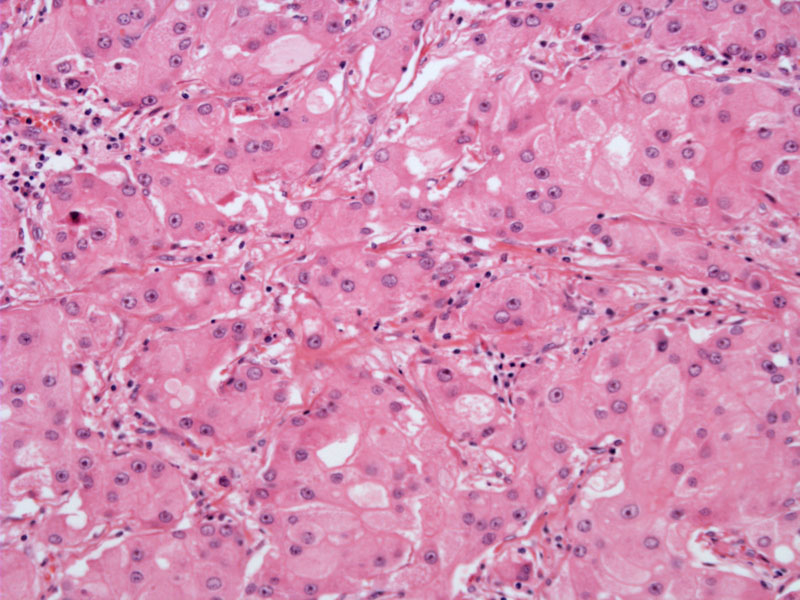

The tumor is predominantly comprised of large eosinophilic cells with abundant cytoplasm -- the nuclei contain vesicular chromatin and a single prominent nucleolus.
Apocrine carcinoma is defined as cases with >90% apocrine differentiation of tumor cells. Again, in this second example, there are large cells with prominent pink flocculent cytoplasm, with sharply defined cell borders. On low power, the possibility of granular cell tumor might be considered.
Aporcine carcinoma consists largely of cytoplasm, but the nuclei are malignant. These tumors are also characterized by ER/PR negativity and positivity for androgen receptor.
Apocrine carcinoma is a rare neoplasm, comprising between less than 1% to 3% of all breast cancers. The definition and etiology of apocrine carcinoma remains elusive, but it is generally considered a variant of ductal carcinoma.
Rosen defines apocrine carcinoma for neoplasm which "all or nearly all of the epithelium has apocrine cytologic features", but the definition is obviously subject to interpretation.1
Apocrine carcinomas tend to be immunoreactive for GCDFP-15 and CEA. Benign apocrine lesions are usually not reactive for p53, but up to 68% of carcinomas demonstrate p53 positivity.1
In one of the larger studies to date, a comparison between 57 patients with invasive apocrine carcinoma (IAC) and 1583 patients with invasive ductal carcinoma (IDC) revealed the following features: (1) patients tend to be older (mean age of 58.5 versus 54.4 years for ductal carcinoma); (2) patients had lower rates of axillary node metastasis and lymphatic invasion; (3) tumors were more likely to be ER and PR negative; (4) no significant difference in prognosis between IAC and IDC (Tanaka).
Another unique feature is the tendency for unilateral multicentricity, although this was noted in one small study and requires additional larger studies to corroborate this feature (Takeushi).
Multiple studies suggest that there is no significant difference in overall survival rate between patients with apocrine carcinoma and non-apocrine carcinoma (Abati, Takeuchi, Tanaka).
• Invasive Carcinoma - Special Types : Lipid Rich Adenocarcinoma
1 Rosen PP. Rosen's Breast Pathology. 3rd Ed. Philadelphia: Lippincott Williams & Wilkins; 2009: 536-549.
Tanaka K, Imoto S, Wada N et al. Invasive apocrine carcinoma of the breast: clinicopathologic features of 57 patients. Breast J. 2008 Mar-Apr;14(2):164-8. Epub 2008 Jan 31.
Takeuchi H, et al. Clinicopathological feature and long-term prognosis of apocrine carcinoma of the breast in Japanese women. Breast Cancer Res Treat. 2004 Nov;88(1):49-54.
Abati AD, Kimmel M, Rosen PP: Apocrine mammary carcinoma. A clinicopathologic study of 72 cases. Am J Clin Pathol 94: 371–377, 1990